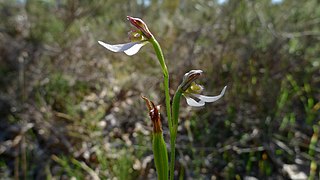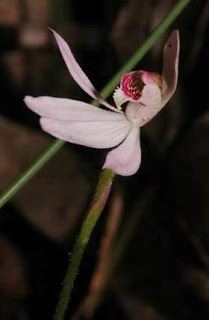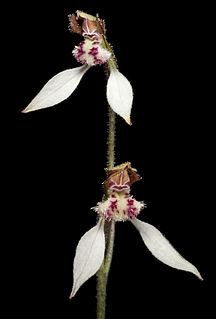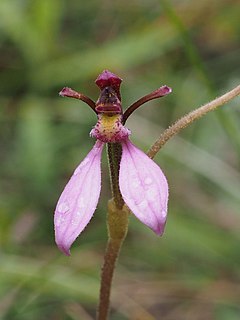
Eriochilus, commonly known as bunny orchids, is a genus of flowering plants in the orchid family, Orchidaceae that is endemic to Australia. Orchids in this genus are distinguished from those in the similar Caladenia by having a glabrous leaf and a densely woolly labellum. Species occur in south-west Western Australia, South Australia, Queensland, New South Wales, the Australian Capital Territory, Victoria, and Tasmania. Their common name alludes to their prominent ear-like lateral sepals.

Caladenia curtisepala, commonly known as short-hooded fingers, is a plant in the orchid family Orchidaceae and is endemic to south-eastern Australia. It is a ground orchid with a single hairy leaf, and a single white to cream-coloured flower with a white labellum with red bands.

Caladenia flava subsp. sylvestris, commonly known as the karri cowslip orchid, is a species of orchid endemic to the south-west of Western Australia. It has a single, hairy leaf and up to three pale yellow and cream-coloured flowers which are white near the tips of the sepals and petals and marked with bright red or pink.
Caladenia armata is a plant in the orchid family Orchidaceae and is endemic to the Australian Capital Territory. It has a single dull green leaf with purple blotches near the base, and a single cream-coloured to pink flower with red to maroon markings. It is only known from a single population containing fewer than ten plants.

Prasophyllum sylvestre, commonly known as the forest leek orchid, is a species of orchid endemic to south-eastern Australia. It has a single tubular, bright green leaf and up to thirty faintly scented, pale green, pink and reddish-brown flowers. It is similar to P. fuscum and P. affine but differs from them, including in the habitat in which they grow.
Prasophyllum litorale, commonly known as the coastal leek orchid, is a species of orchid endemic to southern continental Australia. It has a single tubular leaf and up to forty flowers with red and green colouring and grows in sandhills near the sea.

Eriochilus helonomos, commonly known as the swamp bunny orchid, is a plant in the orchid family Orchidaceae and is endemic to Western Australia. It has a single pointed leaf and usually a single white or cream-coloured flower with reddish brown markings. A relatively common species, it usually grows in swampy places. It is distinguished from other bunny orchids by the arrangement of its petals.

Eriochilus dilatatus subsp. dilatatus, commonly known as the white bunny orchid, is a plant in the orchid family Orchidaceae and is endemic to Western Australia. It has a single narrow leaf and up to seven greenish and white flowers with reddish or mauve markings. A widespread and common species, it grows in a range of habitats and flowers prolifically after fire.
Eriochilus dilatatus subsp. brevifolius, commonly known as the blunt-leaved bunny orchid, is a plant in the orchid family Orchidaceae and is endemic to Western Australia. It has a single small, smooth leaf with wavy edges and a pale red lower surface, and up to three greenish and white flowers with red or mauve markings. It is distinguished from the other subspecies by the colour of the lower surface of its leaf and by its later flowering period.
Eriochilus dilatatus subsp. magnus, commonly known as the Easter bunny orchid, is a plant in the orchid family Orchidaceae and is endemic to Western Australia. It has a single large, smooth, flattened leaf and up to twenty five dull green, red and white flowers. It is found in high rainfall areas between Perth and Albany.
Eriochilus dilatatus subsp. multiflorus, commonly known as the common bunny orchid, is a plant in the orchid family Orchidaceae and is endemic to Western Australia. It has a single short, smooth, flattened, egg-shaped leaf and up to twenty dull green, red and white flowers which are often closely packed. It grows in forest and woodland between Perth and Albany.
Eriochilus dilatatus subsp. orientalis, commonly known as the eastern bunny orchid, is a plant in the orchid family Orchidaceae and is endemic to Western Australia. It has a single short, smooth, flattened, egg-shaped leaf and up to seven dull green, red and white flowers on a fleshy flowering stem. It only occurs on the coast near Caiguna.

Eriochilus dilatatus subsp. undulatus, commonly known as the crinkle-leaved bunny orchid, is a plant in the orchid family Orchidaceae and is endemic to Western Australia. It has a common orchid in the wheatbelt and has single narrow egg-shaped leaf with wavy edges and a maroon underside. Up to three dull green, red and white flowers are borne on a wiry flowering stem.

Eriochilus dilatatus, commonly known as the white bunny orchid, is a plant in the orchid family Orchidaceae and is endemic to Western Australia. It is a common and widespread, slender ground orchid with a single leaf and up to fifteen small white and greenish flowers with reddish or brownish markings and a hairy labellum.

Eriochilus magenteus, commonly known as the magenta autumn orchid, is a plant in the orchid family Orchidaceae and is endemic to south eastern Australia. It is a slender ground orchid with a single leaf and one or two small, bright pink to magenta flowers. It is only found in higher areas of the Australian Capital Territory, southern New South Wales and north-eastern Victoria.
Eriochilus petricola is a plant in the orchid family Orchidaceae and is endemic to New South Wales. It is a slender ground orchid with a single leaf and up to three small, white to pale pink flowers and grows near rock ledges.
Eriochilus pulchellus, commonly known as the granite bunny orchid, is a plant in the orchid family Orchidaceae and is endemic to Western Australia. It has a single egg-shaped leaf and up to ten small white flowers with red markings. A relatively common species, it grows in shallow soil on granite outcrops. Its fleshy leaf is held above the ground on a thin stalk.

Eriochilus scaber is a plant in the orchid family Orchidaceae and is endemic to Western Australia. It has a single leaf and up to three small red, pink and white flowers. Two subspecies are recognised based on the shape of the leaf and its height above the ground.
Eriochilus tenuis, commonly known as the slender bunny orchid, is a plant in the orchid family Orchidaceae and is endemic to Western Australia. It has a single egg-shaped leaf lying flat on the ground and one or two small pink or pink and white flowers. A common species, it grows in dense, shrubby forest and in winter-wet swamps.
Eriochilus valens, commonly known as the red-lipped bunny orchid, is a plant in the orchid family Orchidaceae and is endemic to Western Australia. It has a single egg-shaped leaf held above the ground and up to four small pink or white and pink flowers. It grows near winter-west swamps and usually only flowers after fire the previous summer.










